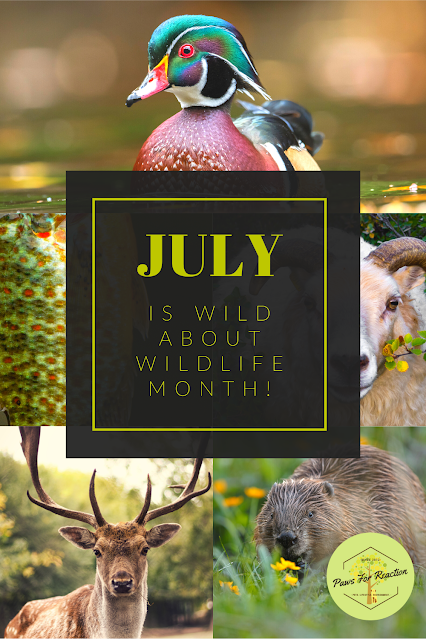Guest blog: What do I do if my dog and I encounter wildlife on a hike?
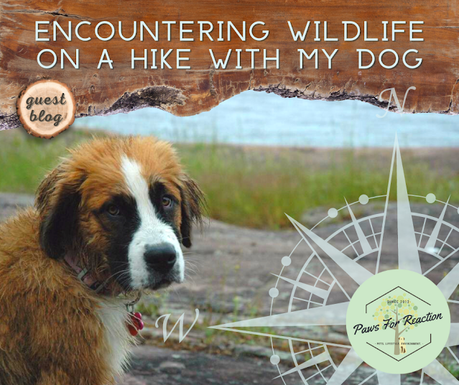
Guest blog by Adeline Ee. Paws For Reaction is so lucky to have such an amazing writer & animal lover join extended our family!
Summer is at our doorstep and it's officially Wild About Wildlife Month- we all know what that means! It’s time to get outdoors, so put on your swimmers and jump in a lake, or grab those boots and hit the trail! Of course, you want to include your pooch in your summer shenanigans. Hiking with your dog is a great way to exercise and bond with your best friend.
Don’t forget, the outdoors is home to all kinds of creatures, not just us hoo-mans and our pups. Some wildlife poses more of a risk to you and your dog than others. So what do you do when you encounter potentially dangerous wildlife on the trail?
It is important to be aware of the common wildlife in the area you're hiking because you may run into these animals. These are some of the wildlife species living in the vast Canadian forests that may pose a threat to you and your dog, and what to do if you encounter them.
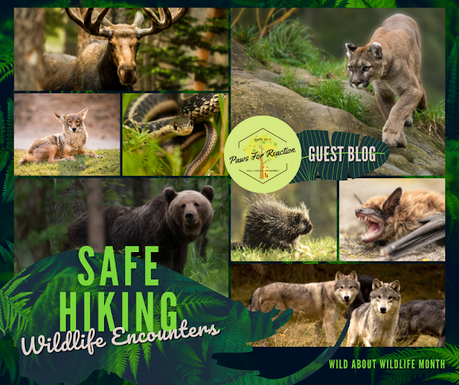
Specific wildlife encounters during a hike
The Canadian backcountry is teeming with wildlife. I mean, tourists come from all over the world and take photos of… squirrels. We have way more than squirrels to impress. Try your best to ensure that your dog does not disturb the wildlife. The best way to ensure your dog's safety from your animal neighbours is to keep your dog on a leash! If you choose to hike with an off-leash dog you assume some risk. Make sure you are very aware of your surroundings.
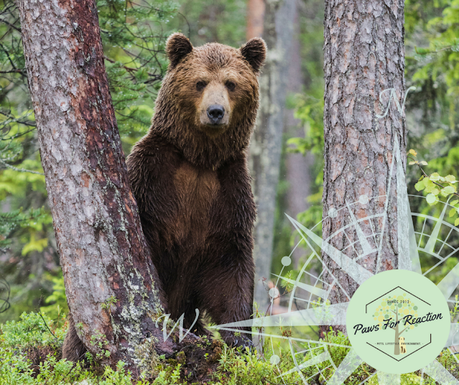
Bears
If you encounter a bear when hiking, even if he appears calm and tranquil, do not approach. If only I had a dollar for every time a tourist stuck a camera in a black bear’s face! Instead, freeze, and walk backwards slowly. Trust me, he already knows you’re there. Don’t run or you might become prey. Bears can reach speeds of over 40 km per hour.
Bears don’t like dogs, and even an aggressive Chihuahua can chase a fully grown black bear up a tree. A dog barking is grating on a bear’s ears, and also remarkably similar to wolves, a predator. Bears also link the presence of dogs to that of humans and usually will take off.
If a bear comes towards you and your dog threateningly, slowly back away from the bear while yelling, swinging your arms, and making enormous dramatic movements to make yourself appear larger. If you see a bear cub you can be sure the mother is close by, even if you don't see her. She will be particularly protective when raising her cubs. Black bears occasionally test positive for rabies in Ontario.
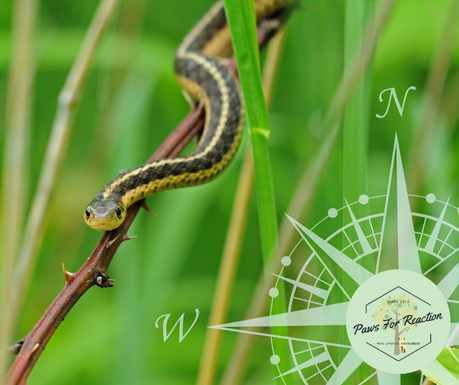
Snakes
If you see a snake don't be alarmed; just a few dozen snakebites are reported each year in Canada. The majority of snakes in Canada aren't deadly or harmful. People might insert their hand or foot into places where snakes hang out, such as holes, beneath rocks, or in bushes.
Walk the trail with gusto. Snakes sense vibrations through the ground and usually move. However, if you or your dog gets bitten, don't try sucking the poison out- that only works on TV. Try taking a photo of the snake to help the snake bite center identify it, and seek medical attention as soon as possible. Reptiles can not get rabies.
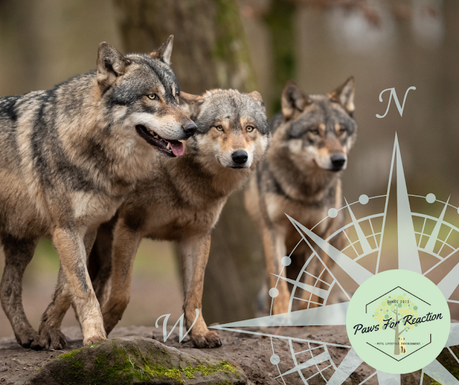
Wolves
Although the chances of you running into a wolf is less common, they do live in the woods. Calmly back away, maintaining eye contact. Do NOT run. Stand between your dog and the wolf; the wolf is likely to be more interested in your dog than you. Most wolves hunt in packs, so if you see one wolf keep a watchful eye out for more.
Sidenote: Wolves are extremely shy and the chances of you encountering one are close to nothing. You’re more likely to get attacked by a goose or a cow. Yep. That shouldn't be a surprise to Canadians. We have all learned the hard way to give Canada Geese lots of space. Wolves are susceptible to rabies but are rarely infected in Ontario.
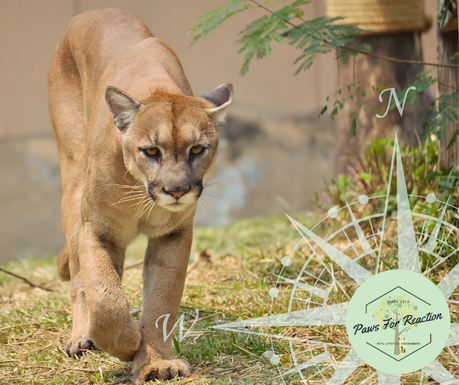
Cougar (a.k.a. Mountain Lion)
It is rare to see a Mountain Lion because they are experts at blending in to the wilderness. If you ever come face-to-face with one of Canada's most dangerous felines, do not run. Rapid movement will elicit an attack response. Slowly back away, gazing at it in the eyes, and never turn your back.
Speak loudly, raise your arms, and hurl rocks at the cat to convince it that you are a threat and not prey. Allow it to flee, especially if it appears cornered by your presence. If the cougar attacks, fight back and don't give up; cougars have been successfully thwarted with rocks and sticks in the past.
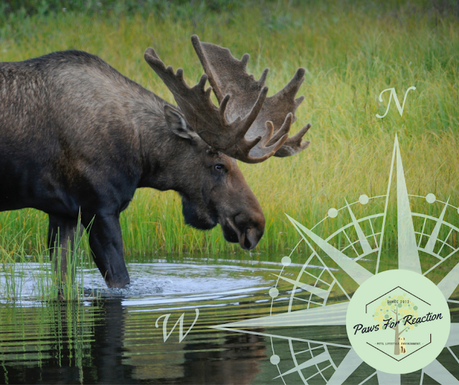
Moose
In deeper territory, you may come across a moose. These formidable creatures can deliver a solid kick that will kill a dog, so keep a wide berth and make a rapid getaway if you come across a moose during hiking.
They may give a "bluff" charge as a warning indication, with their ears back and long back hairs up, when they are about to attack. If a moose behaves aggressively, take a step back with your dog and look for something to place between you and the moose, particularly its antlers- a tree or a car, for example.
Bull moose (male moose) can be aggressive and unpredictable during the fall mating season. In Canada, the fall mating season takes place during September and October. If you see a moose during fall mating season you need to avoid it at all costs, especially if it has antlers. Male moose have antlers and females do not.
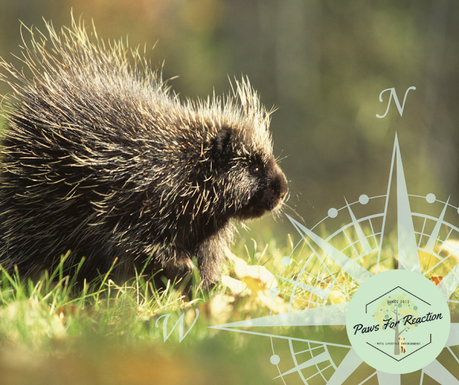
Porcupine
Although other animals on this list appear more dangerous, it is the small but mightily porcupine that seems to do the most damage to dogs. If you come across a porcupine, just steer clear. The little guy doesn’t want any trouble either and is happy to go about its day, but if your dog hassles it or it feels threatened, it could lash out. You may encounter a porcupine where you least expect it- porcupines like to climb trees. If your dog is barking up a tree, it may not be a squirrel.
Our Paws For Reaction expert tip: I have seen countless dogs get quilled by porcupines in my career in the veterinary industry. Typically they are quilled right in the face and their poor little noses. Your dog's first response will be to rub its face on anything- the floor, wall, even you- to attempt to get the quills out. Try your best to prevent that, you do not want the quills to break off.
Also, and I can't stress this enough, DO NOT ATTEMPT TO REMOVE QUILLS YOURSELF. Unless it is one or two quills, your dog will likely need to be anaesthetized to remove the quills. Quills are barbed and often dog owners think they are removing the quills but in reality, they are breaking them off, leaving the barbed part of the quill under the dog's skin. This can cause infection, and more concerning, these pieces of quills can migrate under the skin and pose a serious threat to internal organs and other body parts. They can puncture your dog's lungs, and heart, and even migrate to the eyes. It is also really inhumane.
Your dog will need an anaesthetic and proper removal by a veterinarian, and yes, it will be expensive. Most of the time, quills are covered under pet insurance plans. Removing the quills yourself is not an effective solution to avoiding an emergency vet visit- you will still need to visit the vet to determine if your dog needs antibiotics and you will need to confirm your dog's rabies vaccine status. If the rabies vaccine is expired it is important that your dog receive an updated vaccine.
If your dog is quilled DO NOT show up to your veterinary clinic unannounced, unless you are visiting an emergency practice. Removing quills requires anaesthetic so it is monitored like any surgical procedure. It can also take a long time to remove all the quills with care and search to make sure all quills are removed. This takes a lot of staff and time. General practice animal hospitals may not be able to handle a quills emergency and you will waste valuable time if you just walk in and are then referred elsewhere.
I also want to clear up a common misconception dog owners have. Some folks who would visit with a quilled dog would end up visiting again the following year, again their dog had a face full of quills. The assumption was that their dog would learn and avoid porcupines in the future. I hate to break it to you, but it's highly unlikely that your dog will 'learn' from this experience. Many quilled dogs are repeat offenders. Your dog has predatory instincts that can't be changed and will always want to approach wildlife. Additionally, wildlife typically frequents the same areas every year. If you have a porcupine in the area, it is likely to return every season. Both animals have natural instincts that would bring them together every season. The best remedy for this: leash your dog. Do not attempt to leash the porcupine.

Coyote
Coyotes can be found in both rural and urban regions throughout Canada. They are typically solitary or pair hunters, but can occasionally travel in packs. They are not afraid of people. Small children are at risk, but dogs are more so. Especially smaller dogs but if the coyotes are hunting in a pack they can be dangerous to large dogs. Keep your canine pal on a leash or inside if possible.
Don't run if you see a coyote. Keep your cool and try to scare them away by flailing your arms, yelling, and throwing stuff towards them, but not at them. Coyotes are susceptible to rabies but are rarely infected in Ontario.
Our Paws For Reaction expert tip: A few years ago I attended a parasitology talk that was all about coyotes and a specific threat they pose to dogs. In Ontario, a potentially fatal tapeworm spread by coyotes and foxes was discovered.
The Echinococcus Multilocularis tapeworm (I know, what a mouthful), which had previously only been found in Western Canada, does not make wildlife, including the infected coyote, sick. However, if a dog eats the feces (poop snack!) of an infected animal that contains the parasite egg, it can develop a severe infection called alveolar echinococcosis (AE).
A CDC study showed nearly one in four coyotes and foxes in Ontario residing in the area from Windsor to Ottawa tested positive for the parasite. The parasite is zoonotic, meaning it can be transmitted from your dog (or an infected animal) to humans. Humans and dogs will likely have no obvious symptoms of the AE infection but over time it can do serious damage to the lungs and liver and even cause clusters of cysts on the lungs, liver, and around other internal organs. This can potentially be fatal, and since a dog's body is smaller the attack can be faster and more devastating. AE should not be left untreated.
Since this tapeworm lives in the gastrointestinal tract so it can be difficult to diagnose, even in a fecal test (poop sample). Parasite eggs are microscopic- unless your eyes have the power of a microscope parasite eggs can not be seen by the naked eye. Your veterinarian can do a fecal sample and even send the poop to an outside laboratory to run additional tests and treat your dog with tapeworm treatment if your dog is in a higher risk category. Dogs that hunt wildlife, eat feces or live in an area where coyotes frequent are at higher risk.
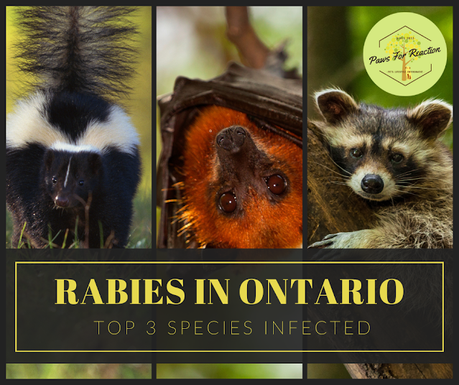
What you need to know about Rabies in Ontario
Rabies is a preventable infectious disease that is fatal to pets and humans. Rabies vaccines are available for you and your dogs and cats. In Ontario, it is a by-law that dogs and cats must have up-to-date rabies vaccinations. Death by rabies is painful and devastating so please vaccinate your pets against rabies.
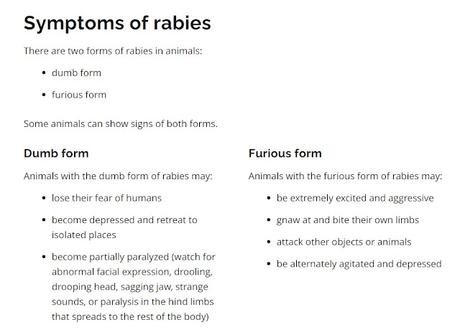
Via Government of Ontario ontario.ca/page/rabies-wildlife
Primary wildlife carriers of rabies in Ontario, according to the current Ontario Government data (2021) are bats, raccoons, and skunks. Historically bats appear to be the number one rabies risk in Ontario. Many wildlife species are vaccinated against rabies in their habitat thanks to the hard work of wildlife conservationists. Bats are difficult to vaccinate. Bats, skunks and raccoons are the three primary carriers of rabies in Ontario, based on historical data. Foxes are also common carriers of rabies. These four animals are often urban dwellers- bats are often found living in people's homes, sheds, and garages. That is why ALL pets should be vaccinated against rabies, not just pets living in forested areas.
Beavers, field mice, groundhogs, rabbits and hares, mink, muskrat, otter, and white-tailed deer are some of the animals that occasionally test positive for rabies in Ontario. Opossums are susceptible to rabies but are rarely infected in Ontario. Non-mammals, including fish, birds, reptiles and amphibians (such as frogs and toads) can not get rabies. Learn more about animal carriers of rabies in Ontario by visiting the government rabies information website.
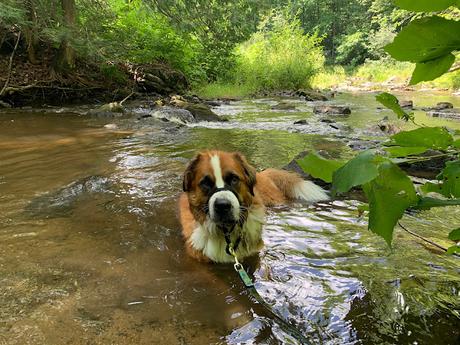
Tips for hiking in the woods with your dog
Wildlife encounters are exhilarating, but since your dog might not know how to behave, it can create a dangerous situation that is downright terrifying. I have some suggestions to help keep your dog safe.
- Even if you are visiting an off-leash area, it is always recommended that you leash your dog. If your dog is not 100% reliably recall-trained, you’re going to have a runaway dog that takes off after whatever is rustling in the bushed. If you chose to let your dog roam make sure your leash is close at hand and easy to grab.
- Use a hiking harness instead of a collar. It will save your dog a potential injury if it lunges on the leash trying to get at a squirrel. Check out some other harness options for different sizes of dogs
- Check your dog’s paws regularly and bring a first aid kit. You don’t want to have a crippled or limping dog in the middle of the forest. Not only is it unpleasant for both of you, but it could also mean your dog is seen as weakened prey.
- Make some noise when you’re hiking- sing or hum to yourself occasionally. That way, you can make your presence known and animals that don’t want anything to do with you can move. The last thing you want to do is surprise a bear!
- Parasite prevention is important! Technically, ticks qualify as wildlife.
- Get to know the land you are exploring by researching common wildlife that calls those woods home. Check out local wildlife sanctuary websites for more advice.
- If you bring food on your hike you could attract animals. Store snacks in a 'smell proof' well-sealed container and don't throw food waste (apple cores, orange peels) on the train. Leave no trace!
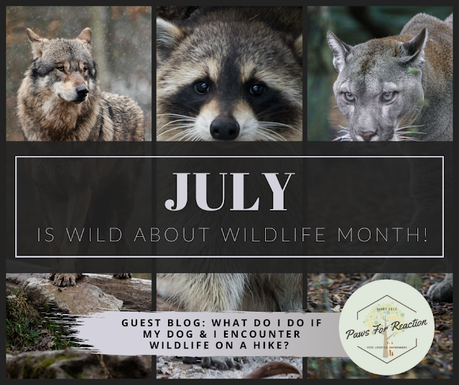
What to do if you find orphaned or injured wildlife
You may encounter an animal you suspect to be injured or orphaned. You probably have a big heart and a love for animals if you are reading this, and will be tempted to rescue the animal. While it could appear the animal is hurt or abandoned, that is not always the case. Before you touch the animal you should contact the nearest wildlife conservation center to inform them of your finding. They will provide you with the next steps to take. You can also contact the Ministry of Natual Resources- this is the first place to call if the animal exhibits signs of rabies. Some local animal control handles wildlife cases, but this is less likely.
Happy hiking, and happy Wild About Wildlife Month!

Give me a high paw and follow Paws For Reaction on Pinterest
Like Paws for Reaction on Facebook
Follow @PawsForReaction on Twitter
Follow @PawsForReaction on Instagram
Follow my blog and subscribe in the sidebar >>
